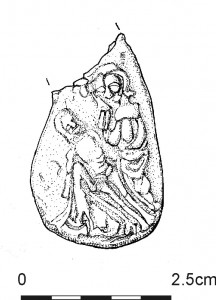During the archaeological excavation in the former East Kirk of St Nicholas several items were found which produced uncertainty as to exactly what they are, where they are from or what their significance is. This is about one such find.

During the excavation a small piece of lead alloy was found on one of the burials, which, on closer examination, was found to have a picture on its surface. On a photograph this does not show up very clearly, so the illustrator working with the team produced a very detailed drawing of what she saw. It emerges that it depicts the Pieta, the body of the dead Christ on the lap of his mother Mary. From the size marker, you can see it is only about 2.5 cm (1 inch) across. The Pieta image is very common and can be found in many churches – there is one in the apse window of St Mary’s Chapel which we will probably feature here next Easter. Mary was a particular focus of devotion around the 15th century at the time that St Mary’s Chapel was being built. This particular item was found with the burial of the lady who had osteomalacia, the adult version of rickets (featured in the post on 6th October 2014), possibly caused by an underlying physical condition.
However, that does not explain what this is, or what its purpose was. One theory is that it was a Pilgrim Badge or Pilgrim Token. These were quite common from the 14th to mid-16th centuries. A very well known example is the scallop shell which featured in our posts on 3rd and 6th March 2014. These tokens were purchased (or collected) by a person on a pilgrimage and worn on an outer garment to show that they had been to that particular holy place. In many ways, they are a parallel to modern day souvenirs. Apart from being a symbol of piety, there were also some superstitions about the protective and healing powers of some of these badges.
At present we do not know the origin of this badge. As far as has been found so far, the design is unique, so it is unlikely to be from one of the ‘well known’ pilgrimage destinations. Could it even be related to our own St Mary’s Chapel? There is no known evidence of pilgrimage to it. Considerably more study will take place as part of the post-excavation studies which still have to be completed once the financial resource is available to pay for them.
(The drawing is copyright Aberdeen Art Gallery & Museums Collections and are used with permission).